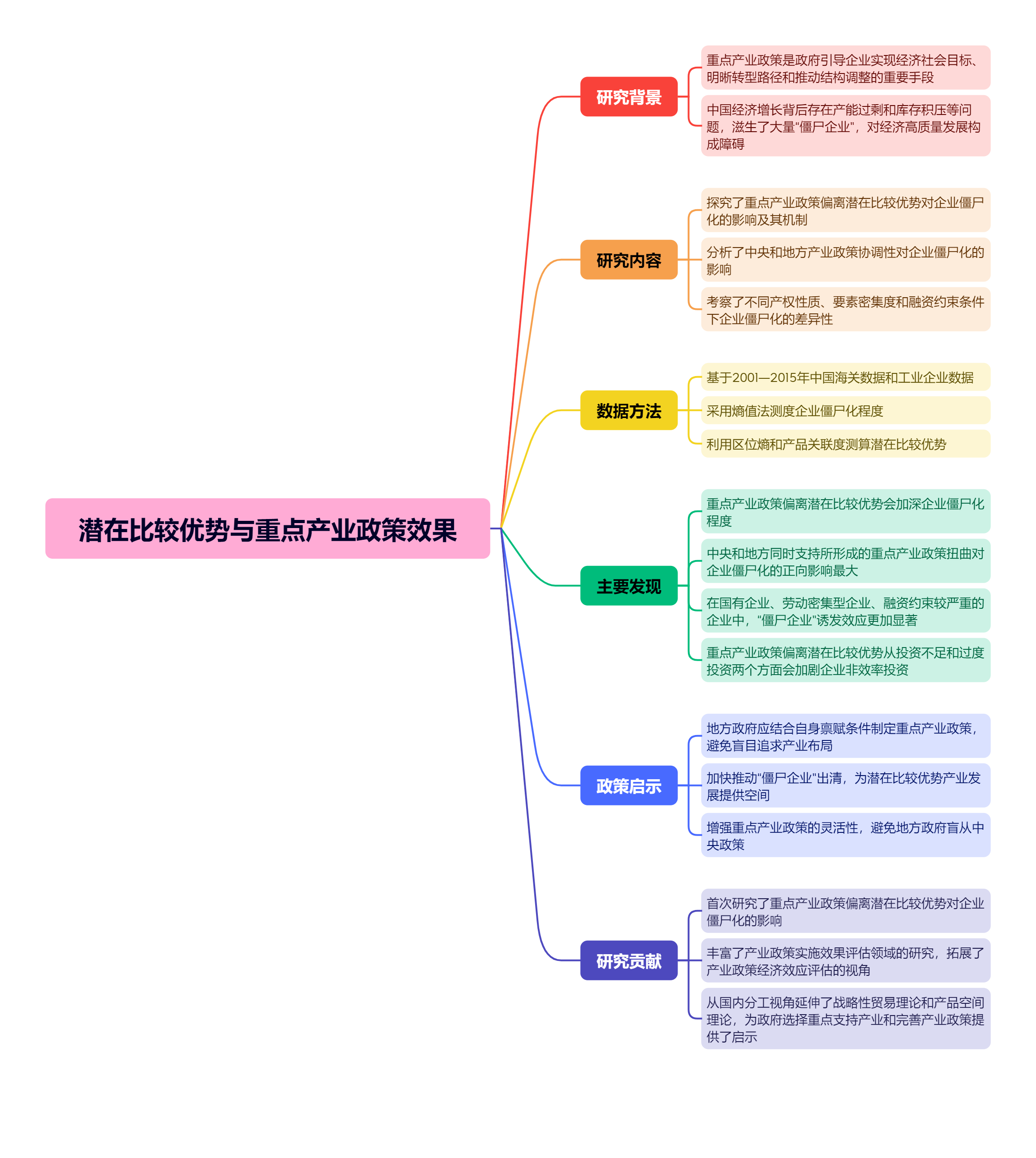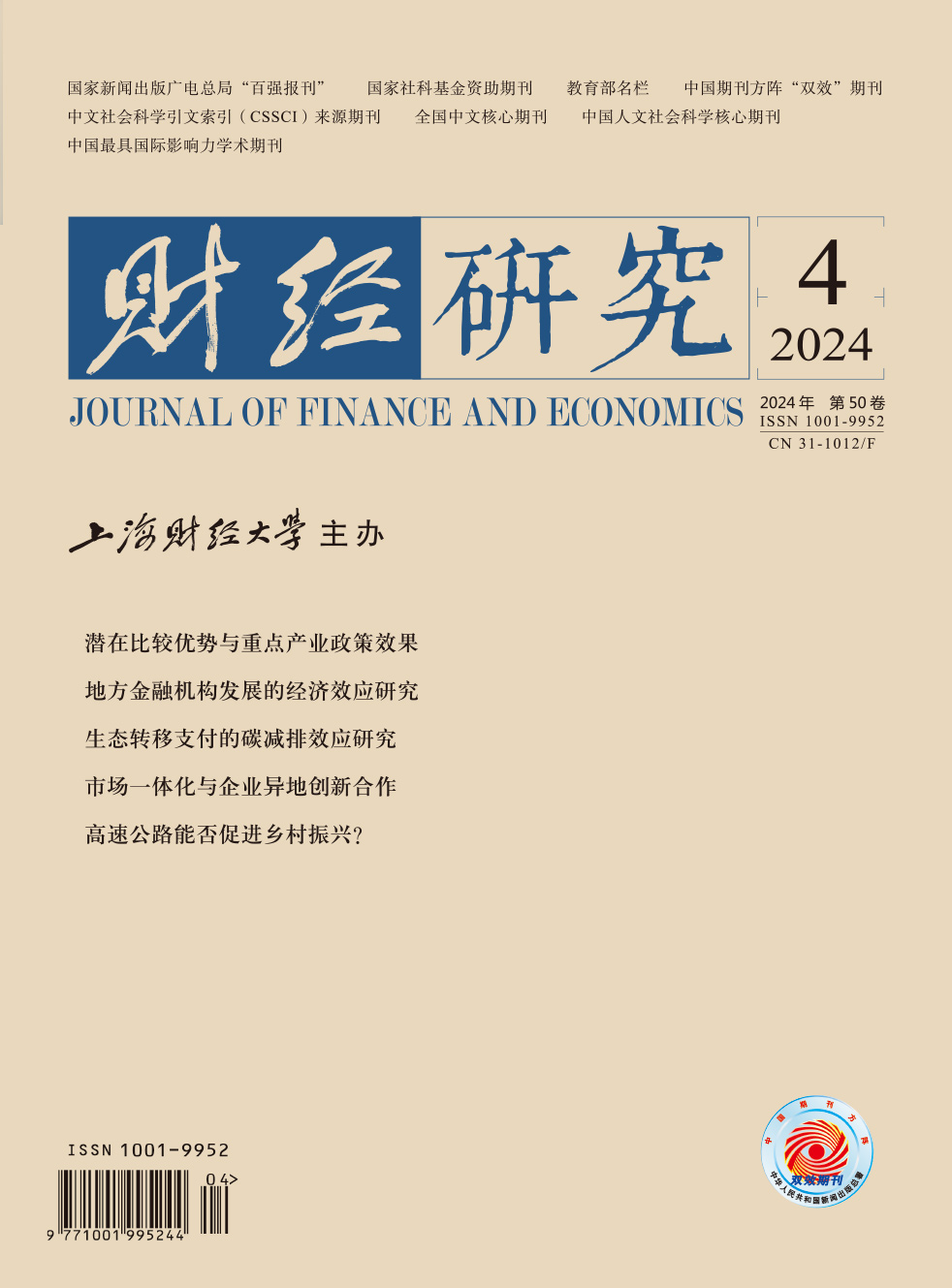重点产业政策是引导企业实现特定经济社会目标、明晰潜在转型路径和推动结构调整的重要手段。文章基于2001—2015年中国海关数据,从行业相似度视角测度了潜在比较优势,然后采用中国工业企业数据,考察了重点产业政策偏离潜在比较优势对企业僵尸化的影响及作用机制。研究发现,当重点产业政策偏离潜在比较优势而产生政策扭曲时,会形成“僵尸企业”诱发效应。考虑央地关系的结果表明,中央和地方同时支持形成的重点产业政策扭曲对企业僵尸化的正向影响最大,而仅地方支持的影响最小。异质性分析显示,重点产业政策偏离潜在比较优势的“僵尸企业”诱发效应在国有企业、劳动密集型企业、融资约束较大的企业中更加显著。机制检验表明,重点产业政策与潜在比较优势的偏离从投资不足和过度投资两个方面加剧了企业非效率投资,并通过挤出正常企业和挤入“僵尸企业”,阻碍正常企业进入和“僵尸企业”复活等方式扭曲了企业进入退出机制,最终加深了企业僵尸化程度。文章拓展了重点产业政策经济效应评估的视角,丰富了“僵尸企业”影响因素的研究,为减少产业盲从行为并唤醒因势利导的产业发展意识提供了有益的政策启示。
潜在比较优势与重点产业政策效果——基于企业僵尸化的视角
摘要
参考文献
相关附件
思维导图
3 刘慧,綦建红. “竞争友好型”产业政策更有利于企业投资效率提升吗——基于公平竞争审查制度的准自然实验[J]. 财贸经济,2022,(9):101−116. DOI:10.3969/j.issn.1002-8102.2022.09.011
5 逯东,宋昕倍. 产业政策能否促进资本“联姻”——基于上市公司设立并购基金的视角[J]. 中国工业经济,2022,(3):114−132. DOI:10.3969/j.issn.1006-480X.2022.03.007
19 Caballero R J,Hoshi T,Kashyap A K. Zombie lending and depressed restructuring in Japan[J]. American Economic Review,2008,98(5):1943−1977. DOI:10.1257/aer.98.5.1943
21 Fu P P,Tsui A S. Utilizing printed media to understand desired leadership attributes in the People’s Republic of China[J]. Asia Pacific Journal of Management,2003,20(4):423−446. DOI:10.1023/A:1026373124564
22 Fukuda S I,Nakamura J I. Why did ‘zombie’ firms recover in Japan?[J]. The World Economy,2011,34(7):1124−1137. DOI:10.1111/j.1467-9701.2011.01368.x
23 Guo X H,Ye J L,Su W H,et al. Do zombie firms crowd out healthy firms and slow their growth? Evidence from China[J]. Development Policy Review,2022,40(6):e12623. DOI:10.1111/dpr.12623
24 Hadlock C J,Pierce J R. New evidence on measuring financial constraints:Moving beyond the KZ index[J]. The Review of Financial Studies,2010,23(5):1909−1940. DOI:10.1093/rfs/hhq009
25 Hidalgo C A,Klinger B,Barabási A L,et al. The product space conditions the development of nations[J]. Science,2007,317(5837):482−487. DOI:10.1126/science.1144581
26 Nunn N,Wantchekon L. The slave trade and the origins of mistrust in Africa[J]. American Economic Review,2011,101(7):3221−3252. DOI:10.1257/aer.101.7.3221
27 Richardson S. Over-investment of free cash flow[J]. Review of Accounting Studies,2006,11(2):159−189.
28 Tan Y Y,Huang Y P,Woo W T. Zombie firms and the crowding-out of private investment in China[J]. Asian Economic Papers,2016,15(3):32−55. DOI:10.1162/ASEP_a_00474
29 Wang X Z,Liu S,Tao Z Y,et al. The impact of industrial policy and its combinations on the innovation quality of wind power enterprises:A study from the perspective of financing modes[J]. Renewable Energy,2022,188:945−956. DOI:10.1016/j.renene.2022.02.057
30 Zhao M,Sun T. Dynamic spatial spillover effect of new energy vehicle industry policies on carbon emission of transportation sector in China[J]. Energy Policy,2022,165:112991. DOI:10.1016/j.enpol.2022.112991
引用本文
杨冉, 贾真, 赖明勇. 潜在比较优势与重点产业政策效果——基于企业僵尸化的视角[J]. 财经研究, 2024, 50(4): 4-18.
导出参考文献,格式为:





 4189
4189  3859
3859


